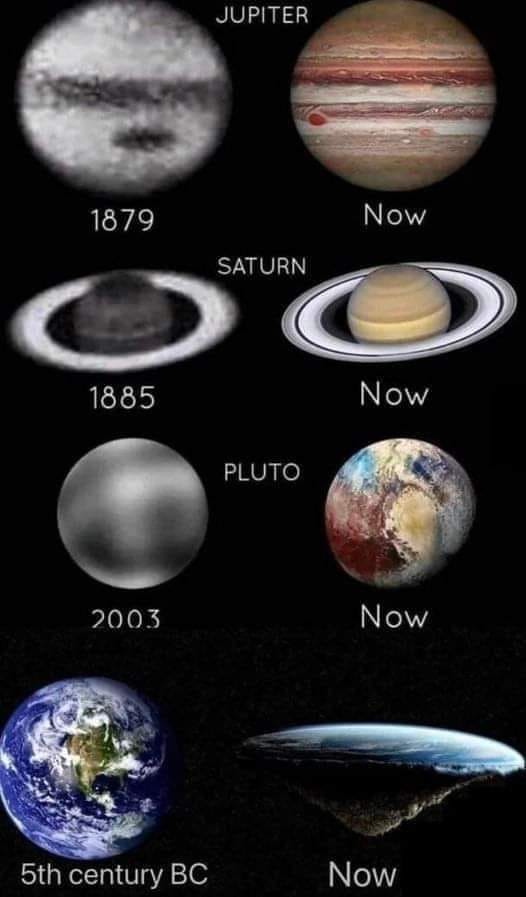Hello everyone,
I've noticed that the Flat Earth Theory still has some traction, and I wanted to create a thread where we can discuss the scientific evidence that overwhelmingly supports the idea that the Earth is a sphere, not flat. Below are some points that could serve as a starting place for our discussion.
The concept that the Earth is not flat is supported by a wide range of scientific evidence from various disciplines, including astronomy, physics, and geology. Here are some compelling reasons:
I've noticed that the Flat Earth Theory still has some traction, and I wanted to create a thread where we can discuss the scientific evidence that overwhelmingly supports the idea that the Earth is a sphere, not flat. Below are some points that could serve as a starting place for our discussion.
The concept that the Earth is not flat is supported by a wide range of scientific evidence from various disciplines, including astronomy, physics, and geology. Here are some compelling reasons:
Astronomical Evidence:
- Lunar Eclipses: During a lunar eclipse, the Earth passes between the Sun and the Moon, casting a round shadow on the Moon. This can only happen if the Earth is spherical.
- Planet Observation: All other planets and celestial bodies we've observed are spherical, not flat. It would be extremely odd for Earth to be the exception.
- Star Constellations: Different star constellations are visible depending on your location on the Earth, which would not be the case if the Earth were flat.
Photographic Evidence:
- Images from Space: Photos and live-streaming video from various space missions and satellites, including those by NASA, clearly show the Earth as a sphere.
- Horizon Curvature: High-altitude photographs and footage (from airplanes, balloons, etc.) show a curved horizon.
Physical Evidence:
- Gravity: The way gravity acts is also consistent with a spherical Earth. Gravitational force pulls objects toward the center of mass, which, in the case of a sphere, is at the center, not spread out across a flat plane.
- Coriolis Effect: The Earth's rotation causes the Coriolis effect, which affects the way air currents and ocean currents move in predictable patterns that are consistent with a sphere.
- Airline Routes: The paths that airplanes take across the Earth make much more sense when plotted on a globe than when plotted on a flat map.
Geographical Evidence:
- Fading Ships: When a ship sails towards the horizon, it gradually disappears from view, bottom first, which is consistent with it moving over a curved surface.
- Polar Circumnavigation: Pilots and explorers have traveled around both the North and South Poles, which wouldn't make sense on a flat Earth model.
Technological Evidence:
- GPS Technology: The Global Positioning System (GPS) relies on about 30 satellites orbiting the Earth, and the system only makes sense when calculated based on a spherical Earth.
Mathematical Evidence:
- Eratosthenes' Experiment: As far back as ancient Greece, Eratosthenes measured the angle of the Sun's rays at two different locations and used the difference to calculate the Earth's curvature, providing one of the earliest pieces of evidence for a spherical Earth.
Geological Evidence:
- Seismic Data: The way seismic waves travel through the Earth after earthquakes also supports a spherical model, with changes in speed and direction that are consistent with varying layers in a sphere.
Navigational Evidence:
- Great Circles: The shortest distance between two points on a sphere is a great circle, and this concept is applied in air and sea navigation. Such paths wouldn't make sense on a flat Earth.
- Lighthouse Visibility: Lighthouses are built tall so their light is visible over the curve of the Earth to ships at sea. On a flat Earth, the height wouldn't be necessary as the light wouldn't be obstructed by a curve.
- Triangulation and Trilateration: Geodetic surveying techniques like triangulation and trilateration make sense only when applied on a curved surface.
Atmospheric Evidence:
- Blue Sky and Red Sunset: The Earth's atmosphere scatters sunlight in all directions, and this phenomenon can be best explained with Earth being a sphere. The red color during sunset and sunrise is due to the curve of the Earth.
- Weather Patterns: Cyclones and anticyclones, characterized by the direction of their spin, are a result of Earth's rotation—another implication of its spherical shape.
- Atmospheric Circulation: The patterns of wind circulation (Trade winds, Westerlies, Polar Easterlies) make sense only on a spinning, spherical Earth.
Radio and Radar Evidence:
- Radio Horizon: Very High Frequency (VHF) radio waves and radar follow line-of-sight paths, and their range is influenced by the Earth's curvature.
- Satellite Dishes: The orientation and angles of satellite dishes are set based on the assumption that satellites are orbiting a spherical Earth.
Other Scientific and Empirical Evidence:
- Center of Mass: The Earth’s center of mass is at its physical center, a characteristic of spherical objects, not flat ones.
- Time Zones: The way time zones work, especially the International Date Line, can only be explained with a spherical Earth.
- Tides: The gravitational interactions between the Earth, Moon, and Sun causing tides are best explained by a spherical Earth.
- Seasons: The tilt of Earth's axis and the resulting seasons make sense only with a spherical Earth.
- Astronomical Alignments: Certain celestial events, like equinoxes and solstices, are explained best by a spherical Earth.
- Air Pressure: Atmospheric pressure changes with altitude, and this is consistent with the laws of physics as they apply to a spherical planet.
- Direct Flights: Certain direct flights between cities in the southern hemisphere (e.g., Sydney to Santiago) are inexplicable on a flat Earth but make perfect sense on a spherical one.
- Foucault Pendulum: This pendulum experiment demonstrates Earth's rotation, which is consistent with a spherical shape.
- Polar Ice: Images and data from polar expeditions reveal a curved horizon, which would not be expected on a flat Earth.






